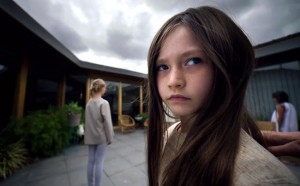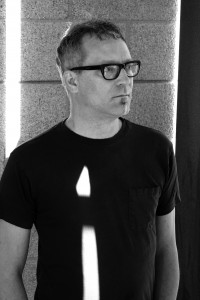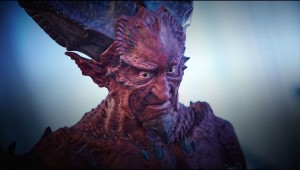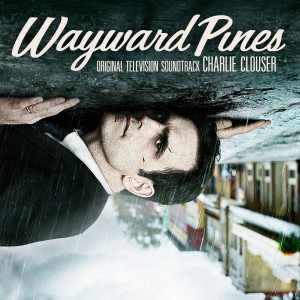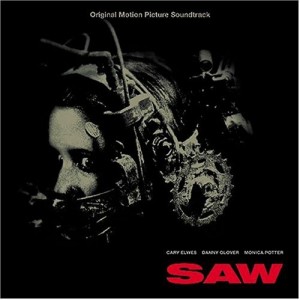Among practitioners of torture horror, Charlie Clouser’s razor-sharp industrial grinds and nightmarish, metallic atmospheres were the anti-tunes to inflict utter doom with in such nastily effective soundtracks as DEAD SILENCE DEATH SENTENCE, RESIDENT EVIL: EXTINCTION and the SAW franchise in particular. Beatific music this wasn’t, even as the Nine Inch Nails keyboardist and award-winning hard rock producer showed that he had more than one stylistic hatchet at his scoring disposal when it came to television, especially in his rhythmic calculations for NUMB3RS and the surreal suspense that filled WAYWARD PINES So forgive us for thinking that Charlie Clouser has seen the heavenly light when hearing the beautifully spiritual score of the SyFy Channel miniseries CHILDHOOD’S END transforming his genre scoring into a thing of transcendent sci-fi scoring – if only it weren’t for the cautious rhythms and eerie voices that tell us the celestial bringers of peace might be anything but benign in their ultimate intentions for Earth.
Such is the power of Arthur C. Clarke’s iconic 1953 novel that SyFy has turned into a grandly powerful, smartly emotional miniseries. It’s but one of the many evolutions this adaptation signifies as it examines multiple crises of faith, from a fighter pilot questioning his role as a spokesman for the “overlords,” the parents of the all-powerful psychic children they’ve planted or a devout Christian faced with the seeming devil himself. Clouser’s score powerfully weaves these stories with a mesmerizingly suspenseful melodic power that ranges from the ethereal to the frightening, hitting every philosophical note of a tale whose imagines of alien invasion, imperious kids and shocking extra-terrestrial personages have since become the visual language of sci-fi cinema and television. Clouser’s score builds with a haunting religious power to a cosmic reckoning for our planet and species, creating a sonic headiness that not only signals the composer’s next creative phase, but also a network’s itself with this epically spiritual close encounter.
ASSIGNMENTX: What did “sci-fi” music mean to you before getting CHILDHOOD’S END?
CHARLIE CLOUSER: The scores to FORBIDDEN PLANET, THE ANDROMEDA STRAIN, 2001: A SPACE ODYSSEY, PLANET OF THE APES, ALIEN and DISTRICT 9 contain most of what I like in the realm of sci-fi music. The bigger, more epic themes tend to sound a little corny to me, so I tend to gravitate towards these scores.
AX: Were you familiar with CHILDHOOD’S END before the assignment? And if not, did you break the book open once you started composing?
CLOUSER: As a kid I was a big sci-fi junkie, and I was way more into that genre than, say, super-hero or fantasy novels, so in high school I had devoured Clarke, Asimov, Bradbury, Dick, and Niven, and in later years got way into Gibson, Sterling, and Stephenson. I had read CHILDHOOD’S END a few times, but it had been a decade or two, so I admit that I cracked it open after I read the screenplay that Matthew Graham cooked up for this version.
AX: CHILDHOOD’S END was a visionary, seemingly unadaptable book that nevertheless presaged such sci-fi conventions as alien invasions and telekinetic, all-powerful superkids. How did those kind of iconic “conventions” musically strike you?
CLOUSER: Honestly I operate mostly by instinct and reflex when it came to CHILDHOOD’S END. It wasn’t as though I had to sit and scratch my head at how to capture this story musically. When the alien ship first appears it’s dread and impending doom, so that’s territory I know well. When the story is dealing with the crumbling of religion, to me that meant a wistful chord progression that folds in upon itself. It starts with a hopeful chord that gets narrower and turns sad but remains noble, if that makes sense. When the children ascend and leave the parents behind, it had to be a rising, upward progression to embody the wonder of what the children will experience while still retaining an element of sadness to represent the parents’ heartbreak at losing their children, and this is best embodied when the son finally ascends in the scene in the cemetery. When Milo finally leaves Earth as a stowaway on Karellen’s ship I wanted the score to have an element of “noble wonder” to call out the magnitude of what he’ll experience while still playing on the woman he leaves behind, and the score during the scene as the ship leaves earth is the best representation of that feeling, and it comes back as he sees Karellen’s home world and encounters the “galactic overmind.” I was a little relieved to find that all of these musical themes came quickly and easily to hand, and there was less bashing my head against the keyboard in frustration than I feared there might be.
AX: You’re best known among genre fans for your visceral approach to the SAW series. Was part of the attraction to scoring CHILDHOOD’S END the chance to compose a far more melodically “peaceful” score than fans might expect from you?
CLOUSER: Absolutely. CHILDHOOD’S END deals with ordinary people experiencing extraordinary events, and is really a human drama, so I knew that it would need a much more delicate touch than the insanity and mayhem of some of the scores I’ve done in the past for movies that were populated by unhinged lunatics committing grievous acts of torture. That’s why there are so many cues with gentle, emotional melodies played on a solo cello, backed by warm, muted string passages. Sure, there are some extra-large epic moments, but really the majority of the score tends toward the smaller, more emotional thematic ideas. By the time we’re in the last hour or two, all of the big sounds and wild sonic pyrotechnics are gone, and the sound palette has shrunk to just strings, solo cello, piano and choir, and the musical themes have narrowed to focus on just three interlocking progressions that represent a calm realization of an inevitable fate, a wistful longing for a future that can never be, and facing certain doom with a noble, stoic, and honorable face.
AX: Nevertheless, do you think there’s the kind of industrial component you’ve used in your horror work to the score?
CLOUSER: In some of the early cues, like when Karellen’s ship first appears, there’s definitely some harsher, more ugly sounds, and as Ricky goes up against the Freedom League people we hear a bit of aggression in the score, but most of that begins to fade as the story focuses on the children. Still, I did use all of my usual techniques for manipulating and processing sounds to give an unsettling quality to the score. Even when it’s sounding small and sensitive, I tried to use a lot of weird synth drones, bowed metal sounds, and time-stretched samples to give a little bit of an unnerving edge to the score.
AX: Is it particularly daunting to have to score a few hours of music for a miniseries, especially one with these kinds of expectations? Did you decide on how many themes you’d have given that amount of work?
CLOUSER: CHILDHOOD’S END wound up having around 120 cues totaling over three and a half hours of score, and I had just under nine weeks from start to finish, so it definitely was a lot of music in a short time frame, but that’s more of an issue of logistics rather than a creative challenge. As I said before, I kind of write by reflex and reaction to the story, so the hard part isn’t coming up with the themes and music, it’s all the elaborate programming and mixing that winds up taking all night. I don’t let the deadline limit my ambition to achieve my musical goals. A short deadline just means I can’t spend all night on twisting knobs trying to perfect a background drone texture or auditioning a hundred different brass sounds. There’s always going to be a thousand more cool sounds to experiment with, that process is a bottomless pit. But when you’ve hit the right melodic idea or chord progression, I think it’s easier for me to say, “Stop! That’s the one!” than it is to do that when fiddling with the knobs on a synthesizer.
AX: Despite the book essentially being a conversational one, how important was it for the score to rhythmically, and dramatically drive a story that had to work for the more conventional arena of television – all while keeping an overall ethereal tone?
CLOUSER: A lot of the scores I’ve done have needed to keep some subtle element of pulse, or rhythm, or a sense of forward motion while still staying fairly low-key, so I’ve had a lot of experience at that and have developed a lot of approaches to keeping the wheels turning without resorting to using drums or overt rhythmic sounds. Even when a cue sounds like a squishy ambient murk I like to keep a rigid metric grid behind it, so I spend a lot of time mapping out the tempo for every cue so that all of the phrases are complete, so that I don’t have to stop one measure short of finishing a phrase or chord progression when the scene ends or I need to turn a musical corner. I’d like to think that this really helps those squishy, murky, non-rhythmic cues sound more musical and less like a drone-fest. I also tend to use very quiet instruments like harp or soft piano to play a very slow pattern behind the murk that helps to give a sense of meter and tempo to all of the ethereal sounds that go on top. It might be because I have some background in song-based composition, but I have a natural aversion to phrases that are seven bars long when they sound like they “want” to be eight bars, so I go to great lengths to make the tempo of my cues allow for symmetrical and complete phrases in all situations.
AX: Given the three-part structure of CHILDHOOD’S END, did you want to differentiate the story themes of each part?
CLOUSER: I definitely felt like there were three phases to the story and the score, and on the first part there’s a lot of big, epic, doom-laden moments as well as some good old-fashioned tension and action moments. In the second part the score turns more toward the crumbling of religion and the fate of the children, so most of the action elements in the score go away and we start to hear little hints of heavenly choirs as well as some musical elements that are almost in the horror genre, as the children start acting almost possessed. Once we get to the third part of the story, it’s all about human emotions, so the score focuses on more emotional sounds and motifs and we hear a lot more of the solo cello and that “noble wonder” theme as Milo leaves on Karellen’s ship. The story is neatly divided into these three chunks, so it was a good opportunity to have the score be pretty different in each part.
AX: The idea of religion as a panacea is a major, striking story theme in CHILDHOOD’S END. Were you surprised by an approach that could be taken as pro-atheist, and how did you want to musically reflect the idea of aliens as assuming the role of God?
CLOUSER: Well, if there is a God, it’s probably an alien of some kind, right? So that idea wasn’t a huge conceptual leap for me. As the children are ascending I almost played it straight, with rising chord progressions and choir-like sounds, although it was decidedly minor sounding and not your usual “heavenly” progression. It was the character of Paretta and her dismay at the crumbling of her religious belief that required a more delicate touch. That was where I used a very simple phrase of chords that had a hopeful-sounding start and then on the third and fourth chords became pinched and strained, and could finish with a downward modulation by a minor third to give a sense of inevitable doom where appropriate. To be honest, I came up with that motif in a couple of minutes. It was as though my hands just made the right shapes on the keyboard right off the bat. Maybe I got lucky on that one?
AX: Another major theme is coming to terms with death. How did you want to musically capture the sense of loss, and transcendence that’s planetary, as well as personal?
CLOUSER: As the story starts to deal with the death of Earth, we really experience it through Milo’s eyes at the same time as he’s seeing the wonders of the cosmos. This was a little tricky, as those two story lines are swapping places and overlapping all through the last hour or so. This is where I was glad that I had written Milo’s “noble wonder” theme in the same melodic and harmonic mode that his “stoic facing of inevitable fate” theme as in. These two musical ideas overlap in the same way that the story line does all through the last hour, with changes in the instrumentation and sounds helping to separate the two. There are big, washy brass and choir chords behind Milo’s wondrous trip into the cosmos, narrowing down to more gentle string chords with solo cello melodies as he’s coming to terms with the end of humanity and deciding that he doesn’t want to stay on as the last survivor. But through all of this, the underlying musical motifs share a commonality that let me switch gears smoothly, without sounding like I’d stopped one idea and started the next. It was a little tricky, but luckily the two ideas shared enough musical DNA that this could happen without sounding jarring.
AX: Could you talk about the “cosmic” orchestrations of CHILDHOOD’S END that seems to occupy a hypnotic place between organic music and electronics?
CLOUSER: I wanted the score to have a mostly organic and acoustic footprint, since this is really a human story. I think there are exactly two purely synthesized sounds used: a simple pulsing synth bass on a few early cues and a long filter-sweep sound later in the score. To me, the “cosmic” aspect of the sound comes partly from the use of choir-like tones along with very distant brass textures. Most of the things that sound like choirs are actually strings or processed guitars that just happened to have a vocal-like quality that caught my ear. Often, when working with heavily processed guitars as I like to do, some combination of filters, pitch shifters, and delay effects will suddenly sound like a human voice, and I’d seize those moments and use those tiny chunks of sound to create that effect. At first I tried to use some of the elaborate sampled choir sound libraries that I have, but this usually sounded forced and cheesy to me, so I tended to favor the more distant sounds that just reminded me of choirs without actually being choirs.
AX: The violin, piano and female voice get especially powerful highlighting in the score. What drew you to them?
CLOUSER: I wanted the score to contain a pretty wide range of emotions, from “mega-doom” to “single teardrop”, but I knew that there were a couple of spots where just one teardrop wouldn’t be enough, and those were the spots where I broke out the solo female vocals. When Karellen gets shot and falls to his knees, and then the nukes finally go off, those are the two scenes where I could have gone for big, epic brass or something, but I went in the opposite direction and had that plaintive female vocal way out in front. That heartbreaking vocal sound is in such stark contrast to the murky, ethereal quality that much of the score has that it really jumps off the screen and punctuates those two moments, and I’m glad I only used it in those two spots so that it really stands out.
AX: How did you want to embody Karellen and The Overlords, especially given their unguessable nature until the series’ very end?
CLOUSER: The only times that I used terrifying sounds in the score for the Overlords is when we’re dealing with people’s reaction to them, like when the ship first lands, or when Karellen first reveals himself. In those kinds of scenes I did use atonal clusters of choirs and other scary sounds, but only to call out the human’s reactions to what they were seeing. When Karellen is talking to Ricky in the fake hotel room, or visiting him at the farm, or Milo is on board their ship, I wanted to score to be calm, benevolent, and noble, since that is the essence of what the Overlords are. They are the opposite of the xenomorphs from ALIEN; they are just here to do a job, to complete a task that has been set in motion many millennia ago. They are not even the architects of this plan, so there’s no need to hate them for what’s inevitably going to happen to mankind. I tried to embody that in the score, and not to make them seem dangerous or malicious. We can be afraid of them, but that’s our problem, because in the long run none of what’s happening isn’t really their fault.
AX: Tell us about playing the “Jesus-God” relationship between Ricky and Karellen.
CLOUSER: To be honest I didn’t play Ricky as the Jesus figure in the score at all, I kept his musical elements focused on his confusion at first, then his frustration, and finally his resignation to his fate and his decision not to stay in the hotel room with his dead first wife forever. These were all story elements that were personal to his character, not part of his mission as mankind’s messiah or whatever, so I only addressed these elements from the point of view of how they affected him, not the rest of humanity.
AX: There’s a sort of 2001-ish quality to your score in how piercing strings and chorus that are used to convey mankind facing an unfathomable power. Was that a conscious choice to hearken back at points to the Gyorgy Ligeti music that Stanley Kubrick placed in Arthur C. Clarke’s most popular film adaptation for this score?
CLOUSER: I admit to attempting my own half-assed low-budget version of Ligeti’s astonishing atonal choir work in 2001. I know I could never hold a candle to his magnificent achievements, but I first saw 2001 when I must have been about seven or eight years old and I was absolutely transfixed by his work. I never heard music or sounds like that before or since, and to me his work is absolutely otherworldly and mind-bending. I still listen to his work often and I remain in awe of the effect it has on my psyche, it makes me feel like I am experiencing something so huge that my tiny human mind could never comprehend even the smallest part. So, yes, I did try to mimic, imitate, simulate, and pay tribute in my own lame fashion Ligeti’s “Lux Aeterna” when we first see Karellen reveal himself to mankind, and I know that my version is a pale shadow of what he accomplished, and I don’t care if I get criticized for daring to attempt such a half-assed knock-off. I had to. I just had to. It was the only choice.
AX: There’s no true “good” or “evil” in CHILDHOOD’S END, which makes the show especially striking. How does that kind of philosophy impact the score? In that way, do you think the music simultaneously borders a place between fear and acceptance?
CLOUSER: Well, the score, like this version of the story, is like a big triangle. It starts wide and gradually gets narrower and more focused until it’s just about one man, Milo, witnessing the inevitable fate of mankind. So in the beginning there are more shades of right and wrong, and a sense of resistance and fighting back against the unstoppable, but that begins to fade and the musical motifs get narrower and the sounds get more placid and peaceful, as though the score is on its deathbed just waiting for the final lethal injection to send it off to rest in peace. I wanted to give the sense that the Overlords were not malicious conquering invaders, but were merely shepherds who are guiding mankind to a peaceful end with as little pain as is possible, given the circumstances. So the moral struggle as embodied in the score starts to fade rather quickly, somewhere in the second part of the story.
AX: What was the creative musical process like with the SyFy Channel?
CLOUSER: I worked quite closely with one of the producers, Todd Sharp, as well as Matthew Graham, who wrote the screenplay, and there was a lot of discussion but actually very few revisions were needed once I was off and running. Early on we talked at length about the emotional focus of each cue and the project as a whole, and there wasn’t a single cue that had to be started over from scratch. Any changes I had to make took the form of adding a swell here, a bit of choir there, and only in one spot did I actually have to go in and change the underlying music. Near the end of the story, when Milo is back on the dying earth and he gets up off the couch and walks past a skull lying on the ground, I had to change about twenty seconds of music. At first I had a feeling of noble resignation, but not too much darkness in that moment, but Todd and Matt both thought that it needed to go heavier there, so I changed the music to modulate downward and have more of a feeling of Milo plodding towards his doom rather than stoically, nobly striding to the end. After he begins to witness Jennifer ascending and the Earth crumbling, the score is back to my first version. So either my first instincts were right, or I got lucky, or maybe both?
AX: You’ve also got plenty of musically surreal puzzle solving of a bigger picture in WAYWARD PINES. Could you tell us about your approach for the show, and what we can expect for its return?
CLOUSER: I just heard that WAYWARD PINES will be coming back for a second season, and I imagine I’ll be starting on that this spring. That’s very different to something like CHILDHOOD’S END. That score needs to have a sense of claustrophobia and isolation and none of the expansive sense of wonder that I attempted for CHILDHOOD’S END. So for WAYWARD PINES I use a lot of smaller sounds that feel like they’re happening inside your head, rather than anything big and cosmic. I also use very different chord voicings and melodic modes; I try to keep the chord voicings tight and small, usually within a single octave, to help give that feeling of claustrophobia, and often use melodies that stay within the center of the chord voicings to help everything feel small and tight. I don’t double things an octave up or down, and I try to keep a wide gap between any low-pitched parts and any of the higher sounds so that everything sounds more separated and isolated.
This isn’t so much an intellectual exercise. It’s just how I react to the story and what I see on the screen. If I play some wide, two-handed part on the keyboard my reaction is, “That sounds wrong for this. It sounds too outdoors, too wide.” If I play a tight voicing with my hands all scrunched together and try to fit everything inside a single octave then my reaction is, “That sounds like it’s happening in between my ears, it feels like the room is getting smaller” and I naturally gravitate in that direction. It’s all instinct, reaction and reflex at this point, none of this is really planned out ahead of time. I don’t write any of these theories down to remind myself how to approach a project, it’s just how I naturally react and respond to the story and the images I’m working with.
AX: With miniseries like CHILDHOOD’S END, do you think television has become the new go-to place for letting movie composers do interesting, experimental work?
CLOUSER: Television has certainly changed over the last fifteen years or so, and now that we’re seeing audiences respond positively to high-quality stuff, whether it’s GAME OF THRONES or HOUSE OF CARDS, I think the networks, cable channels, and streaming services are really stepping up to the plate and spending the time and resources to up their game. I like doing features and television almost equally, and I could never really walk away from either one in favor of the other. Television often has shorter deadlines, but this can be a blessing in disguise, since it’s possible to over-cook things if given too much time to revise and re-visit your work. So I like to alternate between the two as much as possible, but I have no shame in my television game.
AX: If an alien told you that he was going to change the world for the better, would you believe it, especially after scoring CHILDHOOD’S END?
CLOUSER: I’d never believe that the aliens were here to do us any favors. I also wouldn’t assume that we could do a damn thing about it, so I’d try to mimic Milo’s “noble stoicism” as I marched to my inevitable doom!
Watch CHILDHOOD’S END on the SyFy channel, or its website HERE, with its blu ray arriving on Earth March 1. Listen to Charlie Clouser’s scores for CHILDHOOD’S END and WAYWARD PINES on Lakeshore Records HERE and HERE
Related: CHILDHOOD’S END: Interview with screenwriter Matthew Graham
Follow us on Twitter at ASSIGNMENT X
Like us on Facebook at ASSIGNMENT X
Article Source: Assignment X
Article: Interview: Composer Charlie Clouser on Syfy’s CHILDHOOD’s END
Related Posts:








